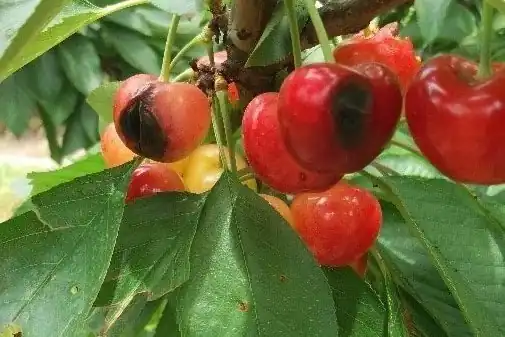According to Héctor García of Diagnofruit, growers’ focus and preparation should be on protecting the fruit with specific fungicides, because “there’s not much room left” as harvest is approaching in many cases.
According to Héctor García of Diagnofruit, growers’ focus and preparation should be on protecting the fruit with specific fungicides, because “there’s not much room left” as harvest is approaching in many cases.
An irregular frontal system, which brought heavy rains in some areas, has created a critical situation for cherries, as this high-value fruit is very sensitive to cracking under conditions of high humidity and rainfall.
It is worth noting that the fruit does not only crack due to direct contact with rain, but also when the roots absorb a lot of water, which is transferred to the fruit, increasing internal pressure until it bursts.
In this context, there is also a risk that diseases, especially fungi, may enter the fruit through the cracks caused by the rain.

Fungal presence and risks
Specialist Héctor García, founder and general manager of Diagnofruit, told Redagrícola that the greatest attention should be given to the most mature orchards, as through the cracks “fungal colonization occurs in most cases, especially by Botrytis and Geotrichum.”
The main threat, he says, is Botrytis, and this is where producers should focus with specific fungicides, because “there’s not much room left” as the harvest is getting closer in many cases.
This is especially true because these cultivars already have a high sugar content and their tissues are more susceptible to fungal invasion when cracks are present.
“That’s why helicopters and drones that remove water from the surface are very useful to contain the onset of the problem,” says García.
Season of high inoculum pressure
According to García, this year has been particularly complex due to the high inoculum pressure, regardless of the unexpected rains of recent days.
“This season, we observed increased pressure from Botrytis and Geotrichum in the qPCR tests we conduct, with different peaks compared to last season. Even without these rains, it was already a complicated season.”
He reports that in the trials, “the control plots that last year had 30% colonization, now are at 60% or 70%, indicating high pressure from this fungus.”
He adds, however, that thanks to proper programs, it was possible to contain and reduce the inoculum levels to normal, allowing preparations for a “heavy” season.
Containment strategies
This is due to the intermittent rains and seasonal humidity, which increase fungal pressure, but García also notes that with the arrival of heat and the dry season, “I have the impression that by December we may see more outbreaks of alternaria,” urging growers to stay alert.
DO NOT CUT COSTS
García recommends applying Tebuconazole, an intervention “that must not be skipped” immediately. For fruit that is not yet ripe, he advises following established programs and adding Tebuconazole if not already included.
“There are seasons when producers skip some applications, but that is not possible today. Applications must come first. The idea is to avoid cutting costs by reducing treatments, because there’s a lot of inoculum circulating, regardless of the rain or whether the fruit has cracked or not.”
This is even more important because in 2026 the Chinese New Year will be late (February 17), so fruit sales will be slower and cherries will need to have long shelf life. “Work in the field is necessary to ensure a good product, with a low risk of infection.”
He also adds that in the event of more rain, “the ideal is to anticipate the event by 24 or 48 hours and have the orchard already treated with fungicide at the time of the rain. Then reinforce the strategy. Today the problem is called Botrytis, and a botryticide such as fenhexamid, fludioxonil or carboxamides must be present, especially on more mature fruit. The goal is to protect the wounds and prevent infection.”
Use of biological products
It is also important to consider varieties more prone to cracking, due to thin skin or high sugar content, which are more vulnerable to fungi and “must be protected more intensively.”
García also emphasizes the complementary use of bioproducts, particularly Bacillus and extracts such as cinnamon or tea tree oil. These products help to “fill the spaces where the fruit is cracked and assist us in this fight against infection.”
“Even very close to harvest, they can help reduce fungal pressure from pathogens such as Penicillium,” adds the Diagnofruit director.
Source: redagricola.com
Image source: Valeria Arriagada
Cherry Times - All rights reserved













